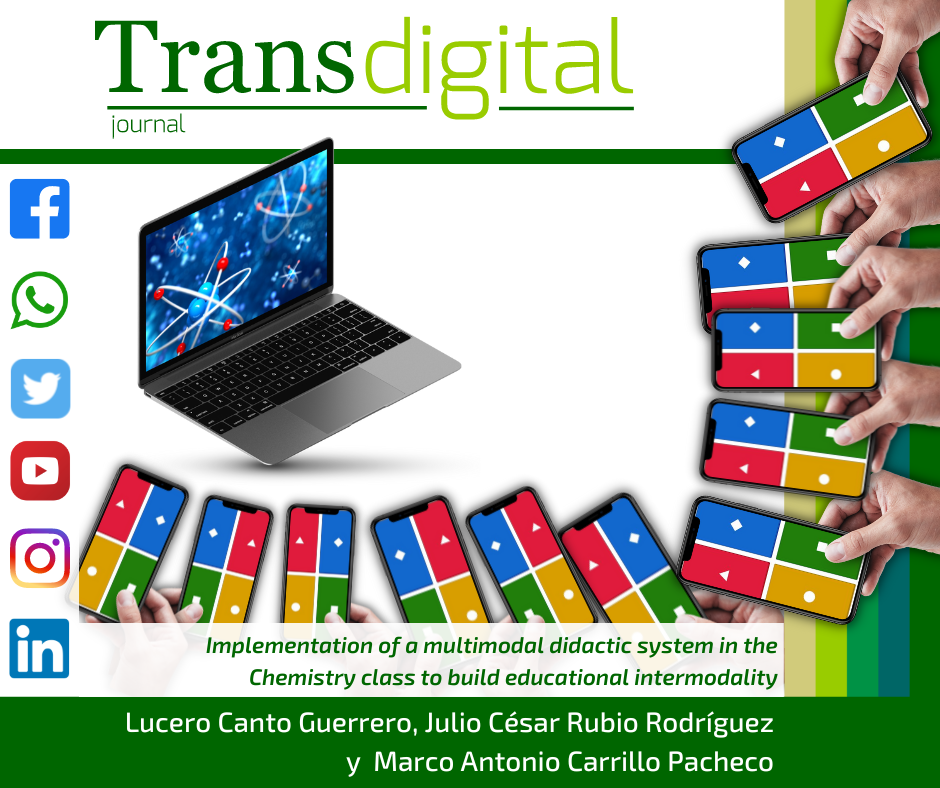Implementation of a multimodal didactic system in the Chemistry class to build educational intermodality
DOI:
https://doi.org/10.56162/transdigital138Keywords:
educative intermodality, multimodal education, information a communication technologies, upper secondary educationAbstract
The low school performance in the Chemistry class at the Upper Secondary Education is a multifactorial phenomenon: lack of motivation, the sociocultural context, and the lack of innovative study techniques. The traditional model of behavioral teaching does not increase the interest in students; therefore, it is necessary to use an educational model based on constructionism that implements and incorporates information and communication technologies. The aim of this study was to implement a multimodal didactic system that would allow us to achieve educational intermodality in ??Chemistry to improve the academic performance of students from the EBA-UAQ Campus Sur of the Autonomous University or Queretaro, Mexico. The research method was as follows: different educational platforms were analyzed, and virtual teaching material was developed. The project was carried out with first-semester students who took Chemistry I, divided into two groups: a control group, in which the students took the subject using a traditional model, and the intervention group, where they took the subject with a multimodal model. Both populations were compared in terms of academic performance in the class. The results suggest that the students belonging to the intervention group presented an increase in the partial grades and the failure rate decreased. The main conclusion is that implementing a multimodal model that allows us to take the step to intermodality is a strategy that helps improve the teaching-learning process and establishes a guideline aimed at educational continuity.
References
Alonso, F., López, G., Manriquea, D., Viñes, J. (2008). Learning objects, learning objectives and learning design. Innovations in Education and Teaching International, 45. https://doi.org/10.1080/14703290802377265
Alsawaier, R.S. (2018), The effect of gamification on motivation and engagement, International Journal of Information and Learning Technology, 35(1), 56-79. https://doi.org/10.1108/IJILT-02-2017-0009
Boza, A., Tirado, R., y Guzmán, M. (2010). Creencias del profesorado sobre el significado de la tecnología en la enseñanza: influencia para su inserción en los centros docentes andaluces. Relieve, 16. http://hdl.handle.net/10272/11290
Candela, B. (2018). Desarrollo del conocimiento tecnológico y pedagógico del contenido de la química, de profesores en formación a través de la reflexión de los PaP-eRs y videos. Góndola, Enseñanza y Aprendizaje de las Ciencias, 13(1). 101-119. http://doi.org/10.14483/23464712.12177
Cardellini, L. (2010). From chemical analysis to analyzing chemical education: An interview with Joseph J. Lagowski. Journal of Chemical Education, 87(12). https://doi.org/10.1021/ed1003433
Castro, J., y Briones, E. (2018). Desinterés escolar adolescente en el proceso de aprendizaje. http://repositorio.ug.edu.ec/handle/redug/35400.
Cepeda, O., Gallardo, I., y Rodríguez, J. (2017). La evaluación de los materiales didácticos digitales. Revista Latinoamericana de Tecnología Educativa, 16(2). https://doi.org/10.17398/1695-288X.16.2.79
Chang, R. (2021). Química. 13va. Ed. McGraw-Hill.
Daza, E. (2009). Experiencias de enseñanza de la química con el apoyo de las TIC. Educación Química, 20.
Escudero-Nahón, A. (2019). Intermodalidad educativa: propuesta de desarrollo conceptual con una revisión sistemática y una cartografía conceptual. Desafíos Educativos, 3(6), 19–28.
Frías, M., Arce, C., y Flores, P. (2016). Uso de la plataforma socrative.com para alumnos de Química General. Educación Química, 27, 59-66. http://dx.doi.org/10.1016/j.eq.2015.09.003
Muñoz, O. (2012). Tesis: Praxis Docente y Desarrollo de Aprendizajes Significativos en el Nivel de 2° Medio en la Unidad de Química Orgánica. Facultad de Ciencias.
Ramírez, A., y Maldonado, G. (2015). Multimodalidad en Educación Superior. Háblame de TIC, 2, 19-37.
Reints, A., y Wikens, H. (2014). The quality of digital learning materials. En Know What Works and Why. Kennisnet / UNESCO-IHE.
Reyero, M. (2018). La educación constructivista en la era digital. TCyE. CEF. 12, 111-127. https://doi.org/10.51302/tce.2019.244
Rojano, S., López, M., y López, G. (2016). Desarrollo de tecnologías de la información y la comunicación para reforzar los procesos de enseñanza y aprendizaje en ciencias en el grado de maestro/a en educación infantil de la Universidad de Málaga. Facultad de Química, 27.

Downloads
Autor de correspondencia
El autor de correspodencia se identifica con el siguiente símbolo: *Published
How to Cite
License
Copyright (c) 2022 Lucero Canto Guerrero , Julio César Rubio Rodríguez, Marco Antonio Carrillo Pacheco

This work is licensed under a Creative Commons Attribution 4.0 International License.
All articles in Transdigital are licensed under a Creative Commons Attribution 4.0 International License. Authors hold the copyright and retain publishing rights without restrictions.









